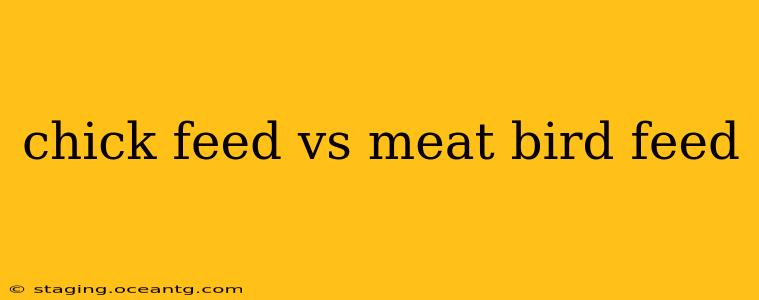Choosing the right feed for your chickens is crucial for their health, growth, and overall productivity. Whether you're raising chicks or meat birds, understanding the nutritional differences between chick feed and meat bird feed is essential. This comprehensive guide will explore the key distinctions, helping you make informed decisions to ensure your flock thrives.
What is Chick Feed?
Chick feed, also known as starter feed, is specifically formulated to meet the unique nutritional needs of young chicks (typically from day-old to about 8 weeks old). These tiny birds have rapid growth rates and require a diet high in protein, energy, and essential vitamins and minerals to support their development. Key characteristics of chick feed include:
- High Protein Content: Usually around 20-24%, significantly higher than adult chicken feed. This supports muscle development and overall growth.
- Increased Energy Density: Chicks need a lot of energy to grow quickly, so chick feed often has a higher calorie content than other types of feed.
- Essential Vitamins and Minerals: Includes crucial nutrients like vitamin A, D3, E, and K, along with calcium and phosphorus, vital for bone growth and immune function.
- Small Crumble or Meal Form: The smaller particle size makes it easier for young chicks with underdeveloped beaks to consume and digest. This minimizes feed wastage.
- Medicated Options: Some chick feeds include medication to prevent or treat common chick diseases. Always check the label and consult with a veterinarian if needed.
What is Meat Bird Feed?
Meat bird feed, also called broiler feed or finisher feed, is designed for faster-growing breeds raised specifically for meat production. These birds require a highly caloric and protein-rich diet to maximize weight gain in a shorter period. The main distinctions from chick feed are:
- High Energy Density: Even higher calorie content than chick feed to support rapid weight gain.
- High Protein Levels: Typically around 18-22% protein, though this can vary slightly depending on the bird's age and growth stage.
- Specific Amino Acid Profile: Optimized amino acid levels (the building blocks of protein) to ensure efficient muscle growth.
- Larger Pellet or Crumble Size: Larger particle sizes are appropriate for older, larger birds.
- May Contain Additives: Some meat bird feeds contain additives to enhance growth rate and feed efficiency.
What are the Differences Between Chick Feed and Meat Bird Feed?
The primary differences lie in the protein and energy content, particle size, and inclusion of specific additives. Here's a table summarizing the key distinctions:
| Feature | Chick Feed | Meat Bird Feed |
|---|---|---|
| Protein Content | 20-24% | 18-22% |
| Energy Density | High | Very High |
| Particle Size | Small crumble or meal | Larger crumble or pellet |
| Medication | Often medicated (check label) | Rarely medicated |
| Growth Stage | Chicks (0-8 weeks) | Broilers (throughout their growing period) |
Can I Use Chick Feed for Meat Birds?
While you could technically use chick feed for meat birds, it's generally not recommended. Chick feed's higher protein content may not be efficiently utilized by older, heavier birds, leading to wasted feed and potentially health problems. Meat bird feed is formulated to maximize weight gain and feed efficiency in the specific growth stages of broiler chickens.
Can I Use Meat Bird Feed for Chicks?
Using meat bird feed for chicks is strongly discouraged. The higher energy density and the larger particle sizes can lead to digestive issues, nutritional imbalances, and even death in young chicks. Their underdeveloped digestive systems are not equipped to handle the richer, coarser feed.
What Happens if I Feed the Wrong Feed?
Feeding the incorrect type of feed can have several negative consequences:
- Slower growth: Birds might not reach their full weight potential.
- Digestive problems: Diarrhea, constipation, and other gastrointestinal issues can arise.
- Nutritional deficiencies: Inadequate vitamin and mineral intake can lead to weak bones, impaired immune function, and other health problems.
- Increased feed costs: Inefficient feed utilization means higher costs without the desired results.
How Do I Choose the Right Feed for My Chickens?
Always check the packaging to ensure the feed is appropriate for the age and type of chicken. Look for reputable brands that provide complete and balanced nutrition. If you have any concerns, consult with a veterinarian or experienced poultry farmer for personalized advice.
Choosing the right feed is a crucial aspect of successful chicken farming, whether you're raising chicks or meat birds. By understanding the nutritional requirements of each growth stage and selecting the appropriate feed, you can ensure healthy, productive birds that meet your expectations.
